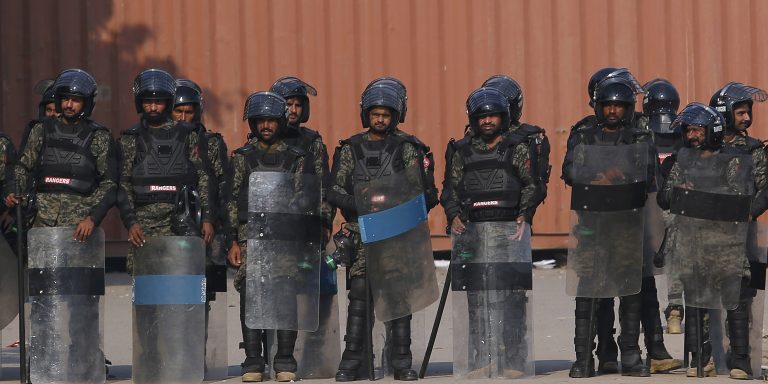INTELBRIEF
March 6, 2019
IntelBrief: The Dangerous Escalation Dynamics of Terrorism

- While Pakistan relies on terrorists as proxies, it remains unclear exactly how much control the military and intelligence services have over certain of those terrorist groups.
- Iran has suffered from a recent increase in terrorist attacks, which could lead Tehran to adopt an aggressive counter-terrorism posture in the region.
- New Delhi directly blames Islamabad for the February 14 attack in Kashmir by Jaish-e-Mohammed, a Pakistani-based terrorist group.
- Global and regional powers are well positioned to pressure Pakistan to rein in militant groups operating on its soil to avoid broader conflicts.
Throughout two days in mid-February, Pakistani-linked terrorist groups launched sophisticated attacks that killed 27 members of the Iranian Revolutionary Guard Corps (IRGC) in southeastern Iran and 40 Indian soldiers in the disputed Kashmir region, respectively. Pakistan has long relied on terrorists as proxies, although it remains unclear exactly how much control the military and intelligence services have over certain of those groups. Pakistan continues to provide various levels of support to an array of terrorist groups, including al-Qaeda, the Quetta Shura Taliban, Lashkar-e-Taiba (LeT), the Haqqani Network, Jaish-e-Mohammed (JeM) and Jaish-al-Adl. The Pakistani Inter-Services Intelligence (ISI) views these groups as a form of ‘strategic depth’ vis-à-vis Islamabad’s much larger and more powerful neighbor, India. However, as witnessed over the past decade, Pakistan has lost control over some of these groups, which then turn on the state. Tehrik-e-Taliban (TTP), or the Pakistani Taliban, is an umbrella organization of numerous militant groups that have waged a violent insurgency against the Pakistani state since 2007.
The attack against IRGC personnel in Iran’s Sistan and Baluchistan province, which borders both Afghanistan and Pakistan, led to a rather direct statement from the IRGC commander, Qasem Soleimani, who stated, ‘if Pakistan fails to punish them in the near future, Iran will do so based on international law and will retaliate against the terrorists.’ Iranian security forces have been battling against the persistent threat posed by Jaish al-Adl since 2013; before that, Iran was grappling with its precursor group, Jundullah. Iran has suffered from an increase in terrorist attacks over the past few years, including from the so-called Islamic State (IS). In 2017, IS launched simultaneous attacks in Tehran, resulting in 17 dead and 43 wounded. While that attack cannot be attributed in any way to the Pakistani state, the cumulative effect of the recent attacks has forced Iran to adopt a more aggressive counter-terrorism posture and could lead to more offensive actions undertaken by the IRGC to disrupt potential attacks and dismantle terrorist networks.
Just one day after the attack in Iran, an attack by JeM killed 40 Indian soldiers in Kashmir, the worst such attack in years. Again, Pakistan was warned, this time by India, to contain the terrorist group that benefits from de facto sanctuary in Pakistani territory. New Delhi followed up that warning with its first air strike in Pakistani territory in decades. A rapid escalation in retaliatory attacks followed, in which two Indian jets were shot down and one Indian pilot was captured before being released. Pakistan has tried in some cases, and at great cost in terms of lives lost, to crack down on terrorist groups, including the TTP, in the various regions where the government has little control, such as the Federally Administered Tribal Areas, as well as parts of southwest Pakistan on the border with Iran. In other cases, however, Pakistan seems reluctant to combat groups it considers to be assets, including LeT and Quetta Shura Taliban.
Too often, terrorism is viewed in isolation, not as a tactic of political or ideological aims, but as a strategy in itself. But the larger context in which in the terrorist activities are occurring are necessary to understand. In Iran, terrorist attacks from IS and groups based in Pakistan have the potential to further exacerbate sectarian tensions and lead to a wider conflagration in the region. In the Indian subcontinent, a single terrorist attack provided the spark that nearly led to the brink of conventional war between two nuclear-armed powers. Historically, terrorist acts have been the catalysts behind several major wars, including World War I. So while it would be a mistake to craft a counter-terrorism grand strategy, as the U.S. has attempted to do since September 11, 2001, it is essential to understand the second- and third-order effects that terrorism and spectacular attacks can lead to. Given the stakes, global and regional powers are well positioned to pressure Pakistan to rein in militant groups operating on its soil, offering security assistance as appropriate and diplomatic pressure where necessary.
.
For tailored research and analysis, please contact: info@thesoufancenter.org
[video width="960" height="540" mp4="https://thesoufancenter.org/wp-content/uploads/2019/03/IB-0306.mp4" poster="https://thesoufancenter.org/wp-content/uploads/2019/03/AP_17330274133138.jpg"][/video]